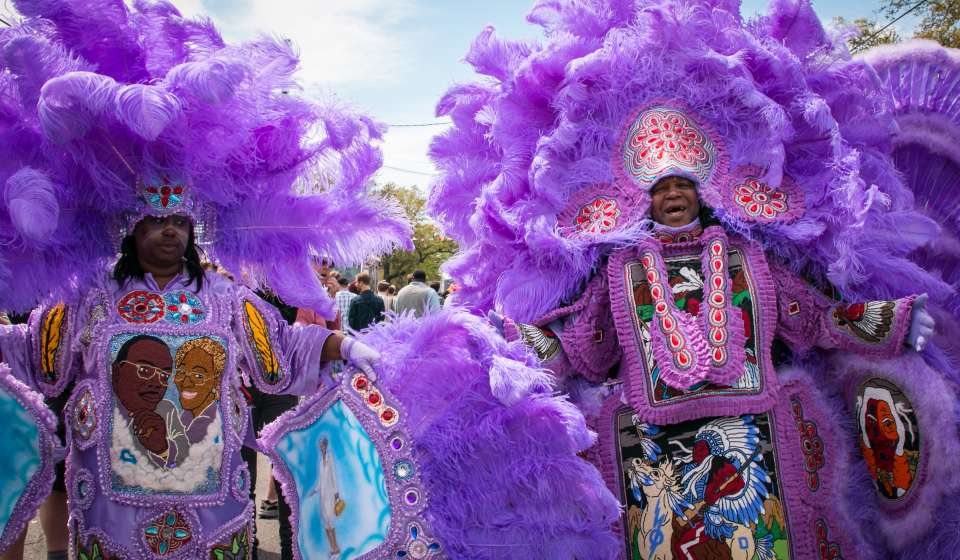
-
Wedding Tools
- Complimentary Planning Assistance
- Destination Wedding Guide Digital Copy
- Elopement Packages
- Marriage License & Legal Essentials
- Checklist
- Welcome Bag Ideas
- Second Lines
- The History of Wedding Umbrellas and More in New Orleans
- Wedding Cake Pulls
- Destination Wedding Guide Printed Copy
- Wedding Inspiration
-
Venues
-
Vendors
-
Pre & Post Wedding
- Wedding Inspiration
- Contact Us
-
Why New Orleans Is Built To Host
- Hotels
-
Meeting & Event Venues
-
Services & Planning Tools
-
Group PR & Marketing Tools
- Convention Calendar
- Testimonials
- Awards
-
Online RFP
- Availability Grid
- Contact Us
-
Things to Do
-
Eat
-
Drink
-
Stay
- Book a New Orleans Hotel
- Hotel Directory
- Bed And Breakfasts: Hotels - New Orleans & Company
-
Places To Stay: New Orleans Hotels - New Orleans & Company
- Saint Charles Avenue Hotels
- Luxury Hotels
- Garden District Hotels
- French Quarter Hotels and Lodging
- Downtown/Central Business District Hotels and Lodging
- Bourbon Street Hotels
- Green Hotels
- Bourbon Street Balcony Hotels - New Orleans & Company
- Haunted Hotels in New Orleans
- Pet-Friendly Hotels
- Historic Hotels
-
Calendar
-
Trip Planning Tools
- Insider's Blog
- LOVENOLA.TV 24/7 Broadcast
-
Weddings
-
Wedding Tools
- Complimentary Planning Assistance
- Destination Wedding Guide Digital Copy
- Elopement Packages
- Marriage License & Legal Essentials
- Checklist
- Welcome Bag Ideas
- Second Lines
- The History of Wedding Umbrellas and More in New Orleans
- Wedding Cake Pulls
- Destination Wedding Guide Printed Copy
- Wedding Inspiration
-
Venues
-
Vendors
-
Pre & Post Wedding
- Wedding Inspiration
- Contact Us
-
Wedding Tools
-
Meeting Planners
-
Why New Orleans Is Built To Host
- Hotels
-
Meeting & Event Venues
-
Services & Planning Tools
-
Group PR & Marketing Tools
- Convention Calendar
- Testimonials
- Awards
-
Online RFP
- Availability Grid
- Contact Us
-
Why New Orleans Is Built To Host
-
Groups
-
Travel Professionals
-
Membership
-
Press and Media
- Community


St. Joseph’s Day
Every March 19, New Orleans Catholics celebrate St. Joseph’s Day by constructing elaborate altars to honor the relief St. Joseph provided during a famine in Sicily. The tradition began in the late 1800s when Sicilian immigrants settled in New Orleans.
St. Joseph’s Day Traditions
Altars
St. Joseph altars, representing the Holy Trinity, are divided into three sections with a statue of St. Joseph at the head. The devout place candles, figurines, flowers, medals, and other items around the altar creating a beautiful, lush, and overflowing effect. Because the altars thank St. Joseph for relieving hunger, offerings of food are added to the cornucopia that anyone is welcome to feast on during the holiday.
You can find these temporary altars throughout the city, including at the locations below:
Irene’s - The Sicilian French Quarter restaurant will host a St. Joseph’s Day altar open to the public on March 18 and March 19 from 5-9:30 p.m. The altar will be blessed daily featuring a seminarian chant. There will also be a reservation-only St. Joseph’s Day feast. To inquire about reservations, call (504) 529-8811 after 4 p.m. Tues-Sat.
St. Joseph Cemetery No. 1 - Located at 2200 Washington Ave., St. Joseph Cemetery No. 1 will host an inaugural St. Joseph’s Day altar on March 19. A blessing by Deacon Richard Brady of St. Louis Cathedral, assisted by Eduardo Melendreras, will occur at 10 a.m. Public viewing is from 10 a.m. to 2 p.m. All are encouraged to bring memorial photographs of their deceased loved ones to place on the altar.
Beauregard-Keyes House - This historic French Quarter residence will have a St. Joseph's Day altar open to the public for viewing from March 16-19, 10 a.m. to 3 p.m. daily. Also on display will be examples of suits made for the Black Masking Tradition of New Orleans, as St. Joseph's Day also coincides with Super Sunday.
Food
Cookies, cakes, and breads, often in the form of shellfish, are common decorations for altars. Fava beans, or “lucky beans,” are particularly associated with St. Joseph because they sustained the Sicilians throughout famine. Pick some up for good luck! As tradition has it, the altar is broken up on St. Joseph’s Day with a ceremony of costumed children, pretending to look for shelter, finding sustenance at the altar. Food and donations are then distributed to the public with leftovers going to the poor.
St. Joseph’s Day Parade
Hosted by the American Italian Marching club, one of the largest cultural group organizations in the southeast, the annual St. Joseph’s Day parade in the French Quarter is a local favorite. The evening begins with food, wine, and Italian music followed by marchers dressed in black tuxedos proceeding to parade until dark. Receive silk flowers and fava beans or dance and sing the hours away with enthusiastic bystanders. The parade will roll on Saturday, March 19 at 6 p.m. with floats and marching bands in the French Quarter.
SUPER SUNDAY
Mardi Gras Indians take to the streets on the third Sunday in March. Clad in colorful, hand-sewn suits, Super Sunday is a sight to behold, a tradition unique to New Orleans. St. Augustine Church in Tremé, a historically Black Catholic church, allowed Sicilians to worship at their church, thus intertwining St. Joseph's Day with the biggest day of the year for Mardi Gras Indians.
No events currently scheduled.
Check back soon or visit our city wide calendar for other great events












